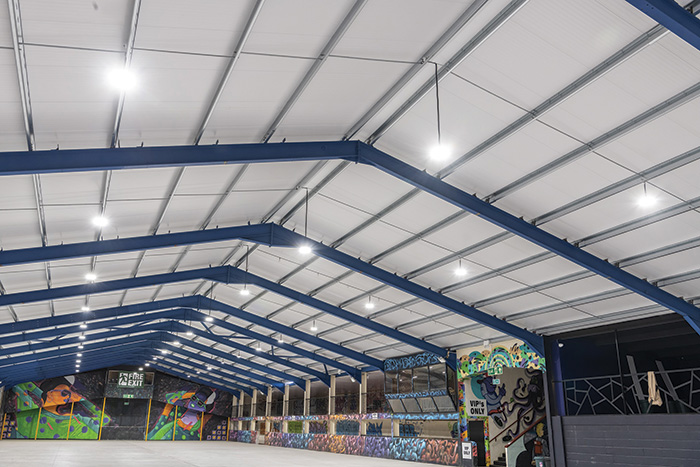Smart Buildings Need Smart Lighting

Revolutionising the built environment, smart technology is proving to be a transformative force. Shaping the way buildings are used, managed and monitored, the impact of smart technology extends far beyond functionality, enhancing operational efficiency, reducing costs and creating safer more comfortable environments for occupants.
Standing at the centre of the ever‑evolving landscape of smart buildings is smart lighting. Unsurpassable in terms of delivering lighting efficiency, adaptability, and user experience, it is proving to be one of the most in‑demand technologies for facilities managers to employ.
Measured and precise, smart lighting gives facilities managers the ability to control and automate every element of a building’s lighting. From specifying timed patterns of operation, to brightness, intensity levels and colour temperature, details can be managed with the utmost precision. This level of control not only allows facility managers to create customised lighting scenes, but it also enhances energy efficiency and reduces operating costs – key objectives in any FM role.

Smart lighting is suitable for both internal and external lighting circuits and so any area of a building can be managed with its use. From workspaces to warehouses, ancillary areas and bathrooms to building façades or walkways, it is ideal for spaces of all shapes and sizes.
Where energy use is of particular concern, smart lighting is particularly beneficial in areas where lighting requirements change regularly, such as workplaces that are being used sporadically, corridors or storage areas. Installing smart fittings with motion or presence/absence detection will enable the lighting systems to adapt to varying occupancy levels and natural light conditions, ensuring that these spaces are illuminated only when needed, minimizing energy consumption during periods of low activity.
It is estimated that around 40% of all energy used in commercial buildings in the UK can be attributed to lighting. If you consider then, that a smart lighting can reduce lighting energy use and expenditure by up to two‑thirds, the savings potential and reduction in environmental impact are huge.

As with all technologies, there are many considerations facilities managers should to take into account when approaching a smart lighting installation. The specific needs and requirements of the building or space will largely dictate the scope of the system required, determining whether a fully connected system is necessary or if implementing specific elements of smart lighting technology would suffice. This tailored approach allows for flexibility, ensuring that the chosen solution aligns precisely with the goals, size, and complexity of the environment in which it is deployed.
Wi‑Fi coverage is also a key consideration. As smart lighting systems need Wi‑Fi or Bluetooth to operate, consideration should also be given to the fabric and the structure of the building, ensuring any factors that might restrict signal and functionality - such as the thickness of walls - can be addressed.
Additionally, facilities managers should also consider compatibility with existing infrastructure and systems. Smart lighting solutions should seamlessly integrate with other building management systems, IoT devices, and control interfaces to ensure smooth operation and interoperability.
Scalability and future‑proofing are also important considerations. Smart lighting installations should be designed with scalability in mind, allowing for expansion or upgrades as needs evolve over time. Choosing flexible and interoperable solutions can help future‑proof investments and ensure compatibility with emerging technologies.
Some organisations are wary of installing smart lighting technology due to a misconception that it is difficult and disruptive to fit. On the contrary, smart lighting is incredibly simple and easy to fit, requiring minimal disruption. Operating via Bluetooth and Wi‑Fi, coupled with user‑friendly apps and seamless pairing systems, the setup requires no hub or extensive wiring, with many fittings simply installed like traditional fixtures. These user‑friendly interfaces and intuitive installation processes ensure that organisations can seamlessly transition to smart lighting without significant downtime, making it an ideal option for a wide range of settings.

For larger, more complex building portfolios, dashboard controls are also available. They enable all connected fittings to be monitored centrally and can provide insight and access to lighting systems throughout a building or an estate – not just singular installations. Providing accurate energy measurement in real time, they can support facilities managers to identify further opportunities to reduce unnecessary wastage, aligning with the broader goal of sustainable and efficient resource management.
They can also be used to carry out maintenance testing. Instigating tests automatically and wirelessly, they can highlight remotely whether an individual luminaire or driver is operating outside of expected operational parameters. This in its self has the potential to save hours and hours of maintenance time, freeing up resource for other critical tasks and organisational priorities.
Dashboards are also a great support when it comes to management and reporting. Alongside providing full real time visibility they also store historical test reports and data logs for all connected buildings and systems. This enables those responsible for building maintenance to access information whenever it is required.
An essential component of today’s smart buildings, the benefits of smart lighting and the improvements it can make to facilities managers roles are evident. From simplifying testing/maintenance tasks and enhancing productivity, it can support facilities managers to optimise their time more efficiently. Moreover, it serves as a pivotal factor in the journey towards achieving net‑zero energy consumption. Supporting organisations to reduce energy usage, it significantly contributes to this broader environmental sustainability objective whilst also reducing operating costs and supporting financial objectives.
Click the article to enlarge it.



























































